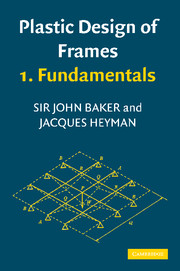Summary
This book presents the basic ideas of simple plastic theory, and should cover the needs of a student of structural engineering up to the level of a first degree. A first course might use material from chapters i and 2 only (perhaps omitting sections 1.6 to 1.8, 2.4 and 2.8) in which direct solutions are obtained to problems of analysis and design. The more sophisticated techniques of chapters 3 and 4 can then be studied, both for their scientific importance, and because they enable a much wider range of structures to be examined.
Each chapter contains a set of examples for the student to work, roughly graded from very easy to really quite difficult. Indeed, the reader who can solve all the examples of chapter 4 may conclude that he has mastered the subject. Since plastic theory makes possible the direct design of steel frames in a way that is not possible with elastic methods, there is some emphasis on practical design problems. The undergraduate may wish to omit most of these problems from a preliminary study of the text, whereas a designer might tackle these first. (The abbreviation M.S.T. 11, followed by a date after some of the examples, indicates that they have been taken from the papers set for Part II of the Mechanical Sciences Tripos, Cambridge, for that year.)
- Type
- Chapter
- Information
- Plastic Design of Frames 1 Fundamentals , pp. vii - viiiPublisher: Cambridge University PressPrint publication year: 1969



